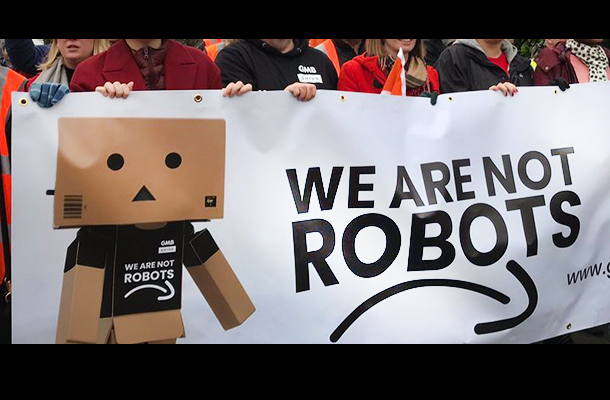As each month goes by, America is a faced with increased reports of problems suffered by Amazon’s ever-expanding legion of warehouse employees tasked with picking and packing millions of parcels per day. Conditions have become so chronic that some Amazon centers are facing breaking point.
In one recent report, Amazon employees described multimillionaire Jeff Bezos’s warehouse operations as “brutal,” and described long hours, relentless spates of physical labor, general fears of taking time off, and even ambulance call-outs for injured or exhausted workers.
Working conditions at Amazon could be described as an American sweat shop.
The Verge reports….

of the strike, an effort had been made to decorate the fulfillment center in Shakopee for Prime Day. There were silvered balloons spelling out MSP1, the name of the warehouse, visible through the glass visitor’s window in the lobby, and walls of smiling Amazon boxes festooned with Prime Day banners. Also in the window: a large, smiling man in a blazer, some sort of security person, but it was hard to say because his ID tag was tucked out of sight in his armpit. Above the turnstiles was written: Work Hard. Have fun. Make History. That sign was permanent.
The week before, the Shakopee workers had announced their intention to strike on the first day of Prime Day, which this year lasts two days. It would be the first work stoppage at a US facility during a peak shopping time, the most ambitious in an escalating series of actions at the Shakopee fulfillment center.
Shortly before 2PM, when the day-shift workers planned to walk out, Hibaq Mohamed and several other workers came into the lobby. Twenty-six years old, Mohamed is originally from Somalia but emigrated to Kenya, then won a visa lottery to come to the US three years ago. Her first job in the country was at Amazon. At first she liked it, but the pace of work had increased to grueling levels, and more and more workers were getting fired for not keeping up.
(…) I true that Amazon pays its full-time fulfillment center employees at least $15 an hour, a change the company instituted in October after criticism from high-profile figures like Bernie Sanders, among others. The company also offers employees benefits, a 401K, and other amenities that make it, on paper, not a bad place to work. But pay and benefits are not the primary reason the Shakopee workers are striking. The problem, worker after worker said, is “the rate.”
Every task in Amazon’s fulfillment centers has a rate. Workers say the two most demanding jobs are “stow” and “pick.” When goods come into the fulfillment center, they’re unboxed and sent to stowers, who scan and place the goods onto the shelves carried by the orange Roomba-like robots that roll along the floor. That item is now in stock.
When an item is ordered, a robot rolls a shelf up to a “picker,” who grabs it, scans it, and puts it on a conveyor belt to be packaged and sent out. Depending on their station, workers are shown a range of graphics displaying whether they’re meeting their rate or falling behind. Some are shown the amount of time they’ve been working and the number of items they’ve scanned, along with a moving average, which drops if you take time to go to the bathroom or have a problem with your workstation. Others are shown a graph that rises and falls, and that turns green, yellow, or red depending on how fast they’re working.
(…) “You have to beat the machine,” said Faizal Dualeh, a Somali immigrant who worked at the facility as a temporary employee for three months. “It’s like a nightmare, all these machines telling you your rate is down.”
If a worker falls behind, they receive a warning. Multiple workers in Shakopee said it was common for workers to be fired on their fourth warning, and that the process felt automatic, with managers deferring to the software.
“Oh, we didn’t fire you, the machine fired you because you are lower than the rate,” Dualeh said, recounting the process.
Robinson, the Amazon spokesperson, said there was “no three strikes you’re out” rule, and that “it is a matter of conversations” managers have with workers. Employees said the conversations are often cursory at best, often amounting to exhortations to work faster. Documents previously obtained by The Verge found that Amazon fired roughly 300 employees over the course of a year at a Baltimore fulfillment center for failing to meet productivity quotas, representing more than 10 percent of the workforce.
When Mohamed started working at the Shakopee fulfillment center three years ago, her rate in stow was 120 items per hour. Now it’s around 280. Workers say they were once permitted one error per 1,000 items. Now they are allowed one error per 2,200. When they make an error, workers say they must work twice as fast to get their ratio back in good standing. Robinson said the rate is “supposed to set a cadence of expectation” and that the goal is to have someone processing an order every 10 to 20 seconds…
Continue this story at The Verge
READ MORE SCI-TECH NEWS: 21st Century Wire Sci-Tech Files
SUPPORT OUR MEDIA PLATFORM – BECOME A MEMBER @21WIRE.TV















